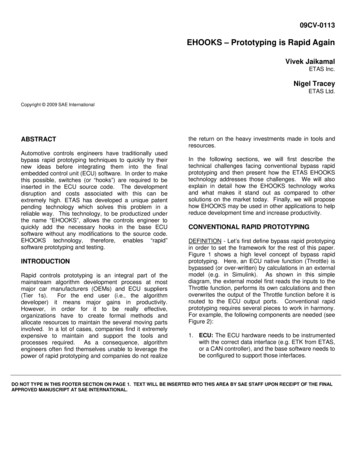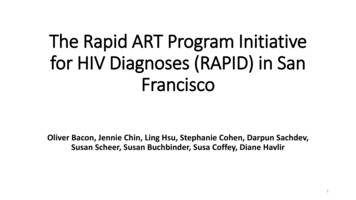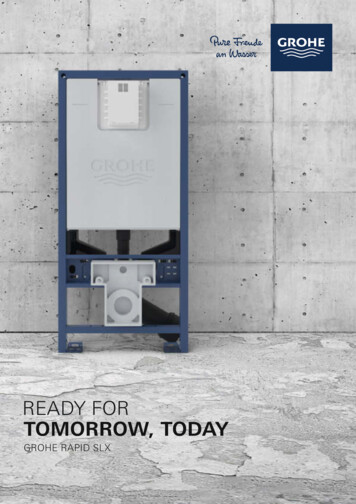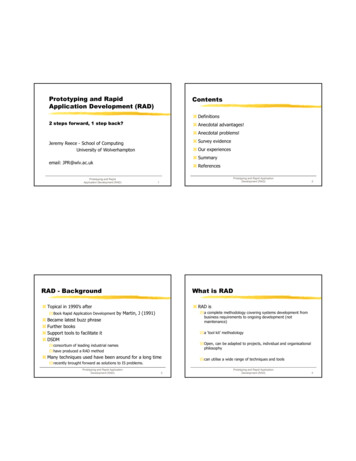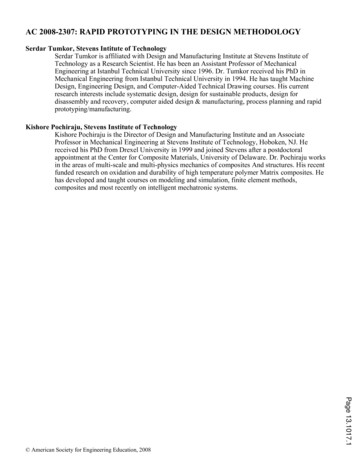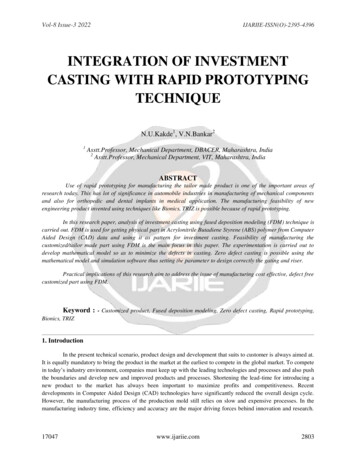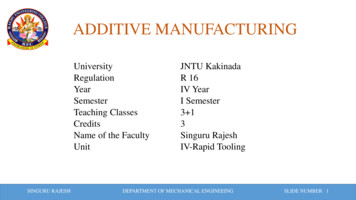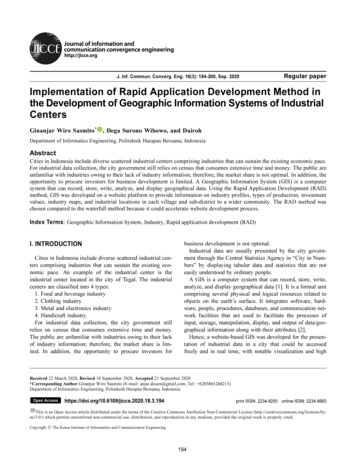
Transcription
J. lnf. Commun. Converg. Eng. 18(3): 194-200, Sep. 2020Regular paperImplementation of Rapid Application Development Method inthe Development of Geographic Information Systems of IndustrialCentersGinanjar Wiro Sasmito* , Dega Surono Wibowo, and DairohDepartment of Informatics Engineering, Politeknik Harapan Bersama, IndonesiaAbstractCities in Indonesia include diverse scattered industrial centers comprising industries that can sustain the existing economic pace.For industrial data collection, the city government still relies on census that consumes extensive time and money. The public areunfamiliar with industries owing to their lack of industry information; therefore, the market share is not optimal. In addition, theopportunity to procure investors for business development is limited. A Geographic Information System (GIS) is a computersystem that can record, store, write, analyze, and display geographical data. Using the Rapid Application Development (RAD)method, GIS was developed on a website platform to provide information on industry profiles, types of production, investmentvalues, industry maps, and industrial locations in each village and sub-district to a wider community. The RAD method waschosen compared to the waterfall method because it could accelerate website development process.Index Terms: Geographic Information System, Industry, Rapid application development (RAD)I. INTRODUCTIONCities in Indonesia include diverse scattered industrial centers comprising industries that can sustain the existing economic pace. An example of the industrial center is theindustrial center located in the city of Tegal. The industrialcenters are classified into 4 types:1. Food and beverage industry2. Clothing industry3. Metal and electronics industry4. Handicraft industry.For industrial data collection, the city government stillrelies on census that consumes extensive time and money.The public are unfamiliar with industries owing to their lackof industry information; therefore, the market share is limited. In addition, the opportunity to procure investors forbusiness development is not optimal.Industrial data are usually presented by the city government through the Central Statistics Agency in “City in Numbers” by displaying tabular data and statistics that are noteasily understood by ordinary people.A GIS is a computer system that can record, store, write,analyze, and display geographical data [1]. It is a formal unitcomprising several physical and logical resources related toobjects on the earth’s surface. It integrates software, hardware, people, procedures, databases, and communication network facilities that are used to facilitate the processes ofinput, storage, manipulation, display, and output of data/geographical information along with their attributes [2].Hence, a website-based GIS was developed for the presentation of industrial data in a city that could be accessedfreely and in real time, with notable visualization and highReceived 22 March 2020, Revised 18 September 2020, Accepted 21 September 2020*Corresponding Author Ginanjar Wiro Sasmito (E-mail: anjar.dosen@gmail.com, Tel: 6285865268215)Department of Informatics Engineering, Politeknik Harapan Bersama, Indonesia.print ISSN: 2234-8255 online ISSN: 94This is an Open Access article distributed under the terms of the Creative Commons Attribution Non-Commercial License (http://creativecommons.org/licenses/bync/3.0/) which permits unrestricted non-commercial use, distribution, and reproduction in any medium, provided the original work is properly cited.Copyright The Korea Institute of Information and Communication Engineering194
Implementation of Rapid Application Development Method in the Development of Geographic Information Systems of Industrial Centersdata complexity comprising spatial and non-spatial data. Thewebsite-based GIS of industrial centers was developed usingthe Rapid Application Development (RAD) method, which isa life cycle strategy that provides faster and better qualityresult compared to the results provided by traditional cycles[3]. Further, RAD is a method of software development withan object-oriented approach to system development [4].Consequently, in this study, RAD was employed as thedevelopment method to design and develop a website-basedGIS to optimize the existing industry market share, facilitatethe public in conducting industry searches, collect data effortlessly on companies in each industry, and attract investors toinvest in the city. The GIS website could display sub-districtdata, village data, industry location data, maps, coordinatepoints, industry profiles, satellite photos, producer data, andindustrial product data with attractive and better visualization.II. RELATED WORKA study result a GIS to estimate and map the occurrenceof dengue and chikungunya in Honduras. GIS has beenwidely applied in the development of epidemiological maps ,including for mapping the occurrence of dengue and chikungunya. The implementation of GIS-based epidemiologicalmaps guides decision makers in preventing and controllingdiseases that still pose significant challenges in certainregions and countries [5].Thakur et al. integrated GIS with remote sensing andglobal positioning system for groundwater hydrologicalmodels, resource management, environmental monitoring,and emergency response. This integration helps to provideand handle several large data sizes that are used simultaneously for efficient time and cost [6].The land-use mapping system built on the website platform was developed in a study conducted by Ginanjar andNishom. The study was motivated by the lack of media publicity and socialization of land use, which affected the extentof improper and inefficient land use. [7].Multi-criteria GISs have been employed to measure climate change vulnerability using the weighted orderedweighted average technique. According to the Monte Carlosimulation-based resilience analysis, this aggregation technique can provide more flexible options and has the potentialto create a vulnerability index compared to traditionalapproaches such as weighted linear combinations [8].GIS can be applied to analyze the performance of sustainable urban transportation based on its five basic indicators—traffic jams, traffic air pollution, traffic noise pollution, trafficaccidents, and transportation infrastructure. The study resultsindicate that the application of GIS in the study of urban transportation performance is dominant in traffic congestion indicators, and GIS is applied to measure the shortest path [9].RAD was chosen as a methodology to develop Dutataniweb applications. Dutatani is a portal and a part of the integrated agriculture information system, which is an agricultural information system comprising several connectedsubsystems. Dutatani can manage users, contents, and linksin this system. The web application was developed in 150days and had gone through several phases—planning, analysis, special design, main design, implementation, testing, andintegration of prototypes. The completion time of 150 dayswas achieved by the supervision and monitoring of teamleaders in optimizing the productivity of all their teams [10].RAD has been employed as a methodology in designinglibrary information systems, resulting in an efficient development time because it only requires 60 working days. Themenu structure displayed in the library information systemindicates that there is a relevant relationship between business processes and the interface system. Hence, the development of this system has a positive effect on servicing themembers and improving management performance [11].Fatimah et al. also employed the RAD method to design thepersonnel information system. This method was applied in thestages of identifying objectives and information requirements,designing systems, building systems, and introducing new systems. Based on the implementation of the RAD method, amore effective and efficient staffing information system wasdesigned. The development of this design required a shorttime; however, it required an effective coordination betweensystem designers and users [12].III. THINKING FRAMEWORKA. Thinking FrameworkThe thinking framework adopted in this study is presentedin Fig. 1.B. Research MethodHerein, after research, the RAD method was adopted todevelop GIS. RAD is an approach to develop informationsystems that is widely discussed in the practitioner literature[13]. RAD is a set of methods that have been developed toovercome the weaknesses of traditional system developmentmethods such as the waterfall model and its variants [14].This method is applied in the quick application developmentcycle and provides good quality software compared to thoseprovided using traditional software engineering approaches.Through a rapid software development process, the organization can cost-efficiently develop and maintain software [15].RAD is a more flexible and adaptive application development model that can change user requirements and ensurefast-growing system quality at minimal costs [16]. In its195http://jicce.org
J. lnf. Commun. Converg. Eng. 18(3): 194-200, Sep. 2020The development of the website GIS of the industrial center using RAD method and its implementation in Tegal cityare as follows.A. System DesignThe website design of the GIS of the industrial center usedUnified Modeling Language (UML). UML is a family ofgraphical notations supported by single models, which helpsto describe and design software systems, particularly systemsthat are developed using object-oriented programming [18].A UML model employed in developing WebGIS of industrial centers is based on use case diagrams and sequence diagrams. A use case diagram is a UML diagram that is used todescribe the expected functional requirements of a system[19], whereas a sequence diagram is a UML diagram thatillustrates the interaction between in and around the systemobjects (including users, displays, and forms) in the form ofmessages described with respect to time [20].B. User InterfaceFig. 1. Thinking framework.The GIS website of the industrial center was developedwith the PHP (Hypertext Preprocessor) programming language and MySQL database. PHP is a programming language that is widely used to handle the creation anddevelopment of a website and can be used in conjunctionwith HTML [21]. MySQL is a database management systemthat uses basic structure query language commands [22].C. DiscussionFig. 2. RAD models.implementation, RAD emphasizes a short planning processand focuses on the software development process thatincludes development, testing, and feedback [17].The phases of the RAD model are illustrated in Fig. 2.IV. RESULT AND DISCUSSIONThe GIS of industrial centers was developed with a website platform; the website platform was implemented inTegal city, Indonesia.In this study, the GIS of industrial centers that had beendeveloped using the waterfall method was compared to arecently developed GIS of industrial centers using the 194The development team leader, responsible for the completion of the GIS development, plays a vital role in controllingand supervising every team member and their work, suchthat each stage in the RAD can execute according to theplan; therefore, the completion time is faster and more costefficient.The phases of the RAD method applied in the development of the GIS of the industrial center can be explained asfollows.1) PlanningThis stage was the initial phase in the development of thesystem. In this stage, information regarding the problemidentification and data collection, in the form of primarydata, were directly obtained from users or final result-oriented users. All user requirements related to the design ofGIS were obtained. The user and the team conducted meetings to identify the goals of the application or system and theinformation requirements arising from those objectives. Theorientation in this stage involved planning to overcomeexisting problems. The primary data were obtained from the196
Implementation of Rapid Application Development Method in the Development of Geographic Information Systems of Industrial Centersindustry, trade, cooperatives, and SMEs in the city area.2) AnalysisIn this stage, the data that had to be used in the developmentof GIS were analyzed. In addition, the GIS users of industrialcenters were analyzed according to their individual requirements. There were 4 types of users—super administrators /management, city/district governments, entrepreneurs, and thecommunity. Every user (except the community) had theauthority to manage their respective data; this affected the features of each user.3) DesignOnce the analysis stage was completed, the next stage wasto create a design based on the results of the analysis conducted. The design referred to in the RAD method was ageneral and detailed system design overview using UML,user interface / user experience display design, and databasetable design. Prior to the designs being used as a primaryreference in the implementation stage, the design was agreedupon by the user.4) ImplementationThis stage translated the design into programming codes.In this case, the product was a website that had been developed in accordance with user requirements. In building thiswebsite, the programming language used was PHP with theCodeIgniter framework and MySQL database and Arc GISfor the visualization of the map. The GIS of the industrialcenter appears as illustrated in Figs. 3-5. GIS could displayindustry locations, maps, coordinate points, industry profiles,and satellite photos. Furthermore, the statistical visualizationcould present graphs of industry profiles, producer data,industry addresses, number of workers, investment value,production capacity, production value, raw materials, andtype of production in each village or sub-district in everymonth and year.After the completion of GIS-based coding, the next stagewas to test the system, by feeding every input to the developed website platform, processing it, and investigating certain errors. Moreover, the testing was conducted to ensurethat the create, read, update, and delete (CRUD) process performed efficiently. Examples of certain system test resultsare presented in Table 1. The results of the test indicated thatall CRUD functions were successfully conducted withouterrors.The implementation of the RAD method for developingthe GIS of the industrial center, implemented in Tegal city,Indonesia, had been successfully completed within 12 weeksor 84 days in accordance with the explanation presented inTable 2. This was 5 weeks faster than that taken by thewaterfall method to develop similar GIS of the industrialcenter and implement it in the district of Tegal [23]. Thissuccess was because of the vital role played by the teamleader who was able to manage existing resources optimallyand communicate every achievement of the stages of theFig. 3. Display map of district industrial center.197http://jicce.org
J. lnf. Commun. Converg. Eng. 18(3): 194-200, Sep. 2020Table 1. Final design parameters of the proposed antennaValue (mm)Fig.Parameter4. Display of industrialmenu.ParameterValue (mm)W30lc3.7L30wc1R s110.9θs35ow s14θf20oR s26.4gs0.5w s21l11.5wf3l27gf0.3l36.1lf13h0.8Fig. 5. Display of industrial statistics menu.RAD method with the user; consequently, the completion ofsoftware development was faster and ultimately affected thecost efficiency and productivity of resources.The result was that the RAD method could increase thespeed of system development with better software quality[24]. This method was appropriate for software .194on a small to medium scale. The effective and efficient communication between team members, team leaders with allteam members, and team leaders with users was a determinant of software development using the RAD method beingsuccessfully conducted.198
Implementation of Rapid Application Development Method in the Development of Geographic Information Systems of Industrial CentersTable 1. List of system testing activitiesTest IDDescriptionTest InputResult1sign inusername, passwordsuccessful2sign out-successful3user datauser identitysuccessful4district datadistrict profilesuccessfulsuccessful5village datavillage profile6industrial dataindustry profilesuccessful7company datacompany descriptionsuccessful8statistic datadetailed statistical datasuccessful9news datacontent news datasuccessful10comment datacontent comment datasuccessfulTable 2. Development time of GIS of industrial centersStagesDurationNumber of TeamPlanning2 weeks1Analysis1 week1Design2 weeks1Implementation7 weeks2V. CONCLUSIONSBased on the aforementioned results and discussion, it couldbe concluded that the GIS developed with the website platform could provide following information about villages andsub-districts that are industrial centers in a city/regency—industrial locations, maps, coordinate points, industrial profiles, and satellite photos. Furthermore, this GIS could provideoutputs in the form of graphs about industry profiles, producerdata, industry addresses, number of workers, investment value,production capacity, production value, raw materials, andtypes of production in every village or sub-district in everymonth and year. The GIS of the industrial center was achievedfaster because it was developed using the RAD method. It wasaccomplished within 12 weeks or 84 days with better quality;this was faster than the waterfall method running in the districtof Tegal. Therefore, it affected the cost efficiency and optimization of the productivity of existing resources.REFERENCES[ 1 ] K-T. Chang, Introduction to Geographic Information System,McGraw Hill, 2002.[ 2 ] M. F. Goodchild, “Twenty years of progress: GIScience in 2010,”Journal of Spatial Information Science, vol. 1, no. 2010, pp. 3-20,2010. DOI: 10.5311/JOSIS.2010.1.2.[ 3 ] R. J. McLeod, System Development: A Project Management Approach,NY: Leigh Publishing LLC, 2002.[ 4 ] A. al Dennis, System Analysis and Design Fifth Edition, John Wiley& Sons, Inc., 2012.[ 5 ] L. I. Zambrano, M. Sierra, B. Lara, R-N. Ivan, M. T. Medina, L-R. O.Carlos, and R-M. J. Alfonso, “Estimating and mapping the incidenceof dengue and chikungunya in Honduras during 2015 usingGeographic Information Systems (GIS),” Journal of Infection andPublic Health, vol. 10, no. 4, pp. 446-456, 2017. DOI: 10.1016/j.jiph.2016.08.003.[ 6 ] J. K. Thakur, S. K. Singh, and V. S. Ekanthalu, “Integrating remotesensing, Geographic Information Systems and global positioningsystem techniques with hydrological modeling,” Applied WaterScience, vol. 7, no. 4, pp. 1595-1608, 2017. DOI: 10.1007/s13201016-0384-5.[ 7 ] G. Wiro Sasmito and M. Nishom, “Mapping of land use system integal city,” Internal Journal of Research in Engineering andInnovation, vol. 2, no. 5, pp. 498-502, 2018.[ 8 ] D. Runfola, S. Ratick, J. Blue, E. A. Machado, N. Hiremath, N. Giner,K. White, and J. Arnld, “A multi-criteria Geographic InformationSystems approach for the measurement of vulnerability to climatechange,” Mitigation and Adaptation Strategies for Global Change,vol. 22, no. 3, pp. 349-368, 2017. DOI: 10.1007/s11027-015-9674-8.[ 9 ] P. A. Nadi and A. Murad, “Smart societies, infrastructure, technologiesand applications, lecture notes of the institute for computer sciences,”Social Informatics and Telecommunications Engineering (LNICST),vol. 224. Springer International Publishing, 2017.[10] R. Delima, H. B. Santosa, and J. Purwadi, “Development of DutataniWebsite Using Rapid Application Development,” IJITEE (InternationalJournal of Information Technology and Electrical Engineering), vol.1, no. 2, pp. 36-44, 2017. DOI: 10.22146/ijitee.28362.[11] A. D. Supriatna, “Designing library information system using RapidApplication Development method,” IOP Conference Series: MaterialsScience and Engineering, vol. 434, no. 1, pp. 0-6, 2018. DOI: 10.1088/1757-899X/434/1/012259.[12] D. D. S. Fatimah, A. D. Supriatna, and R. Kurniawati, “Design ofpersonnel information systems using Rapid Application Developmentmethod,” MATEC Web of Conferences, vol. 197, 2018. DOI: 10.1051/matecconf/201819703016.[13] P. Beynon-Davies, C. Came, H. Mackay, and D. Tudhope, “RapidApplication Development (Rad): An empirical review,” EuropeanJournal of Information Systems, vol. 8, no. 3, pp. 211-232, 1999.DOI: 10.1057/palgrave.ejis.3000325.[14] B. H. W. and R. M. R. A. Dennis, System Analysis and Design SixthEdition, John Wiley & Sons, Inc., 2014.[15] R. Naz and M. N. A. Khan, “Rapid applications developmenttechniques: A critical review,” International Journal of SoftwareEngineering and Its Applications, vol. 9, no. 11, pp. 163-176, 2015.DOI: 10.14257/ijseia.2015.9.11.15.[16] F. Fatima, M. Javed, F. Amjad, and U. G. Khan, “An approach toenhance quality of the rad model using agents abstract,” TheInternational Journal of Science & Technoledge, vol. 2, no. 13, pp.202-210, 2014.[17] A. B. M. Moniruzzaman and D. S. A. Hossain, “Comparative studyon agile software development methodologies,” vol. V, no. 3, pp. 3756, 2013.[18] J. Booch, G. James, and R. Ivar, The Unified Modeling LanguageUser Guide Second Edition, Addision Wesley Professional, 2005.[19] Karoly Nyisztor, UML and Object-Oriented Design Foundations:Understanding Object-Oriented Programming and the UnifiedModeling Language (Professional Skills Book 1), Kindle Edition,2018.[20] C. Jing, Software Development Life Cycle with the Unified ModelingLanguage, China Press, 2000.[21] D. Carr and M. Gray, Beginning PHP: Master the latest features ofPHP 7 and fully embrace modern PHP development, Packt Publishing,199http://jicce.org
J. lnf. Commun. Converg. Eng. 18(3): 194-200, Sep. 20202018.[22] Chintan Mehta, MySQL 8 Administrator’s Guide : Effective guide toAdministering hight-performance MySQL 8 solutions, Packt Publishing,2018.[23] G. W. Sasmito, “Penerapan metode waterfall pada desain sisteminformasi geografis industri kabupaten tegal,” J. Inform. Pengemb.IT, vol. 2, no. 1, pp. 6-12, 2017.[24] N. M. N. Daud, N. A. A. A. Bakar, and H. M. Rusli, “ImplementingRapid Application Development (RAD) methodology indeveloping practical training application system,” InternationalSymposium on Information Technology, 2010. DOI: 10.1109/ITSIM.2010.5561634.Ginanjar Wiro SasmitoLecturer and researcher in the Department of Informatics Engineering, Politeknik Harapan Bersama, Indonesia. He receivea Master Degree from Diponegoro University, Indonesia. His research interests include information system, softwaredevelopment methodology, and enterprise resource planning. He has several papers to his name in international journalsand conferences.Email : anjar.dosen@gmail.comDega Surono WibowoLecturer and researcher in the Department of Informatics Engineering, Politeknik Harapan Bersama, Indonesia. He receivea Master Degree from Diponegoro University, Indonesia. His research interests include information technology, networkengineering, and enterprise architecture.Email : dega.wibowo@gmail.comDairohLecturer and researcher in the Department of Informatics Engineering, Politeknik Harapan Bersama, Indonesia. She receivea Master Degree from Gadjah Mada University, Indonesia. Her research interests include physics and computation.Email : cce.2020.18.3.194200
the Rapid Application Development (RAD) method, which is a life cycle strategy that provides faster and better quality result compared to the results provided by traditional cycles [3]. Further, RAD is a method of software development with an object-oriented approach to system development [4]. Consequently, in this study, RAD was employed as the


